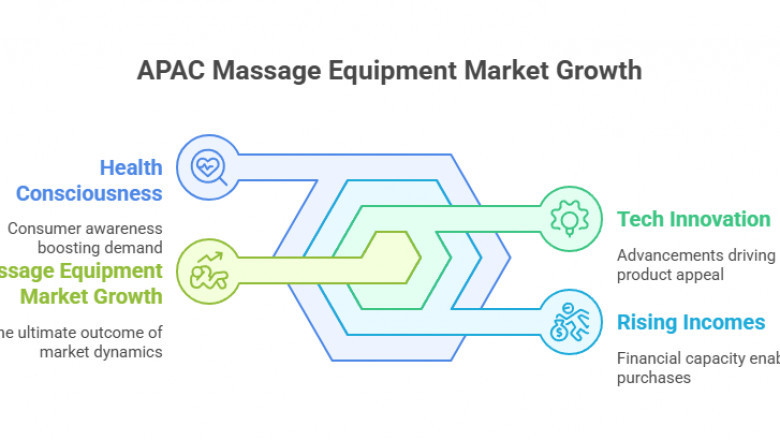views
The Asia Pacific Massage Equipment Market is currently valued at USD 7.1 billion, underscoring strong momentum in the region’s wellness technology landscape. Driven by increasing health consciousness, rising disposable incomes, and the growing preference for home-based wellness, the demand for massage chairs, handheld devices, and foot massagers is scaling rapidly. Innovations in AI and IoT have further redefined how consumers interact with wellness solutions, positioning massage equipment as a core element of urban self-care routines.
Growth Dynamics in APAC Massage Equipment Market
1. Health-Conscious Consumers Fueling Demand
With urban stress levels and lifestyle-related health issues on the rise, consumers across Tokyo, Seoul, Shanghai, and Delhi are prioritizing preventive wellness solutions. According to WHO, musculoskeletal and cardiovascular diseases are increasing in urban Asia, leading many to invest in at-home therapeutic devices like massage chairs and back massagers.
2. Rising Disposable Incomes Expand Market Reach
The IMF reports substantial growth in personal income across China and India. For instance, India's disposable income reached INR 296.3 trillion in 2023, up from INR 273.3 trillion in 2022. This financial growth enables middle-class households to invest in non-essential wellness products, including massage equipment.
3. Tech-Enabled Innovation Leading the Charge
Japan and South Korea are at the forefront of developing AI-powered and sensor-integrated massage chairs, offering personalized therapy sessions. The inclusion of Bluetooth connectivity, voice assistants, and body-sensing technology caters to tech-savvy millennials and Gen Z users, making premium devices both functional and aspirational.
Explore the in-depth industry analysis on Electric Massagers Market Report
Top Players in the APAC Massage Equipment Market
The Asia Pacific market is competitive, with both local innovators and global wellness brands competing to meet regional demand.
-
OGAWA – A major brand across China and Southeast Asia, known for premium massage chairs with advanced recliner functions and app-based control.
-
Panasonic – Offers a broad portfolio of massage equipment blending Japanese craftsmanship with smart technology integration.
-
Fujiiryoki – One of the oldest Japanese brands in wellness electronics, renowned for its high-end therapeutic chairs.
-
Casada – A German brand with strong presence in Korea and Southeast Asia, focusing on ergonomic handheld and foot massagers.
-
OSIM International – Headquartered in Singapore, OSIM leads in lifestyle wellness devices across APAC with a strong omni-channel retail presence.
Explore global trends in North AmericaMassage Equipment Market Analysis for a comparative view.
Key Challenges in APAC Massage Equipment Industry
-
Affordability Concerns: Despite growing interest, high initial costs for advanced massage chairs (often exceeding USD 1,500) limit market penetration in price-sensitive economies like Indonesia and Bangladesh.
-
Cultural Preference for Traditional Therapies: In countries like China and India, acupuncture, Ayurveda, and herbal therapies continue to hold cultural dominance, which diverts attention away from tech-based massage products.
Market Opportunities
1. Expanding into Southeast Asia
Emerging economies such as Vietnam and the Philippines offer untapped potential due to increasing consumer health awareness and rising disposable income in urban centers. These markets are ideal for mid-range massage equipment tailored to first-time buyers.
2. Product Innovation and Smart Integration
The rise of smart wellness ecosystems—where devices sync with health apps, VR environments, and biometric sensors—is transforming the user experience. Manufacturers investing in IoT-enabled massage tools, portable designs, and gamified health interfaces are likely to dominate future consumer demand.
Discover how digital wellness intersects with global trends in Global Massage Therapy Services Industry and Global Fit Massagers Market Trends.
Conclusion
The Massage Equipment Market in APAC is on a robust growth trajectory, powered by evolving health priorities, urban lifestyle changes, and technological innovation. As e-commerce platforms and offline retail channels improve product accessibility, brands focusing on affordability, innovation, and wellness personalization are best positioned to capture market share. While traditional therapy still plays a role in some segments, the convenience and appeal of at-home smart wellness devices will continue to reshape the consumer landscape.
You can also read about: The MEA Industrial Enzymes Market Top Players and Growth














Comments
0 comment